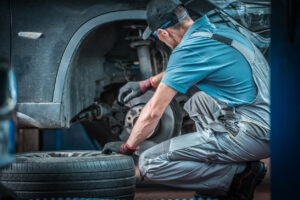Owner-operators have many things to consider when it comes to tire management. Owner-operators are business owners, and as a business owner, it is tough having to deal with everyday expenses. One of these expenses is tire management.

Tire management is something as an owner-operator that you have some control over. Constantly maintaining and inspecting your tires can help lower your cost and help you get the most mileage out of your tires. Three main things go into managing your tires: checking tire pressure daily, monitoring the tire’s wear and tear weekly, and knowing when your tires need to be changed.
Keeping Your Tires in Top Shape
Tire maintenance is often underrated as a daily job owner-operators must do. While it is not just about changing your tires when they wear out – it is about ensuring that your tires are in good condition each time you get behind the wheel and hit the road.
Many factors come into play that could affect your tires:
- Weather – snow, rain, hot and cold temperatures
- Driving habits – accelerating quickly or braking often
- Road types – dirt roads wear down tires more than highways
- Tire pressure
All of these should be considered when thinking about tire management and when running your business as an owner-operator.
What does tire management mean for an owner-operator? It means ensuring your tires are in the best condition they can be so you can get the most miles possible in between tire changes. It also means considering the driving you will be doing and ensuring you check your tire pressure daily, especially in weather changes.
Keep Proper Air Pressure
Keeping your tires properly inflated is very important in tire maintenance. When the weather changes from 90 degrees to 50 degrees – the air within your tire can cause your tire pressure sensor light to come on. So, it is important to check your tire pressure often. It is important to maintain the proper air pressure and do tire inspections often. Inspections should include both inside and outside the sidewalls of the tire.
Check Tire Tread
Your tire tread depth should be deep enough on all tires. A rule of thumb is to stick a penny upside down between the treads with Lincoln. If you can see Lincoln’s face, you should change your tires.
Always Review and Inspect
All owner-operators should perform a detailed tire assessment before hitting the road. During this assessment, you should check – inflation pressure, tread depth, and tracking mileage on tires. It is also important to check your tires throughout your trip if you are on a long haul, and this can help catch early cracks, cuts, or bulges.
Performing pre-trip inspections can help improve tire performance, limit unexpected expenses, and help diagnose any issues that may arise and stop you from continuing your haul.
Rotate and Wheel Alignments
Once you install tires on a truck, you begin wearing and tearing the tire tread. Tires should be rotated every 6,000 – 8,000 miles, and this helps evenly distribute tread wear and help extend the tire’s life. Also, a full three-axel wheel alignment should be done often, and this will help even out wear and tear and get you more miles out of your tires before having to be replaced.
One way to check if tires are out of alignment is to pay attention to the steering wheel. If your steering wheel is off-center and there is some vibration when driving – this could mean your alignment is off.
Fix Issues Immediately
When tire issues arise – these should be fixed quickly before they become severe. Some technologies can help predict tire analytics to help find tire issues early on. By finding these issues early, you can fix them and save money. Typically, a tire leak can be fixed for $30, but if you do not fix it promptly, it can cost an upward of $700 to fix.
Fix minor tire issues before they become critical tire issues.
Check with your tire service company to determine the requirements for tire changes. Most of the time, tires are required to be changed every 35,000 miles. Be sure to monitor how many miles are left on your tire because it can be hard to get into a shop right away to get your tires changed.

